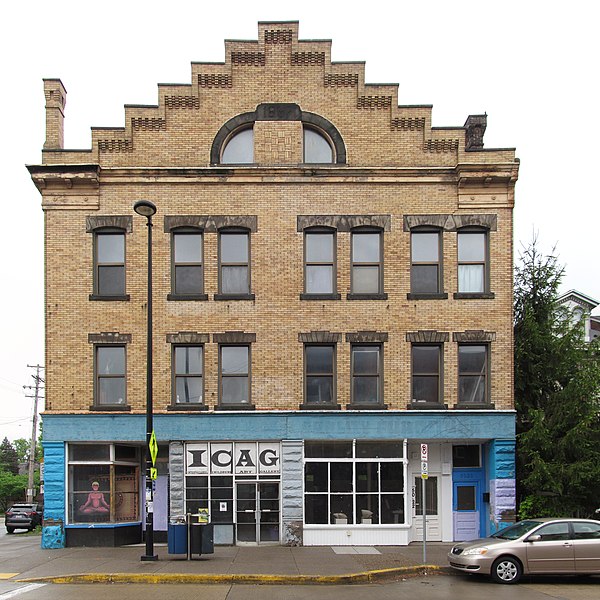
This Art Deco building probably dates from the 1930s. The sharply rectangular forms are softened and enriched by textures in terra cotta, making a composition that should please both classicists and modernists.


What do St. Stanislaus Kostka, St. Mary of the Mount, St. Stephen’s in Hazelwood, a chicken coop turned into an apartment building in Aspinwall, and an empty restaurant on the South Side have in common? The buildings were all designed by Frederick Sauer, who was a genius at ecclesiastical architecture but had to make most of his living designing houses and small commercial buildings for the middle classes. This building was put up in about 1911,1 and we can’t say that it’s a work of towering genius. But Sauer does manage to filter the expected Pittsburghish details through an angular modernism that gives the building a distinctive style. This is how a good architect makes a good living: by taking small jobs as well as big ones, and doing good work for all his clients.


Update: Thanks to our correspondent David Schwing, we know that the architects were Link, Weber & Bowers, an all-star firm of local ecclesiastical architects.1 The article follows as it was originally published.
This is about as perfect as an Art Deco storefront can get. What is especially cheering is that the ground floor is a new construction, using modern stock materials to create a storefront that matches the spirit of the rest of the building. Until a little more than twelve years ago, the ground floor had been bricked up in an unsympathetic fashion, as you can see in a 2008 image from Google Maps.
Father Pitt does not know what the initial K stands for at the top of the façade, and would be delighted to be informed. (Update: K is for H. S. Kossler, who commissioned the building.)


For most of the history of the South Side, this corner at 24th and Carson was the gateway to the long Carson Street retail district. Further out there were a few shops and (especially) bars, but the looming mass of the steel mill dominated the streetscape. Now, of course, the SouthSide Works (spelled with internal capital, which is not old Pa Pitt’s fault) development that replaced the mill has extended the retail district by several more blocks, but this building still marks an obvious break between the new and the old.
The rounded corner is distinctive and emphasizes the building’s function as a gateway. The proper inset entrance not only makes the storefront look characteristically Victorian, but also still fulfills its purpose of not hitting pedestrians in the face with a swinging door—a purpose we have unaccountably forgotten in our modern storefronts. One would think a few lawsuits by pedestrians with broken noses would establish a design precedent, but apparently that has not happened.


This tidy little building has the look of an old meeting house or school, or even a little theater. Do any Elizabeth Township readers know its story? It’s on Smithfield Street in the little hamlet of Boston, just across the Boston Bridge from Versailles.

There was a date stone or plaque in the gable once, and perhaps fairly recently: it was painted around when the current coat of paint was applied.

Kraynick’s Bike Shop is a Pittsburgh legend, and it lives in a slightly bedraggled building that is so typically Pittsburgh it should never be improved. Now that Garfield is coming up in the trendy world, someone is likely to restore this Second Empire storefront sooner or later, but it retains so many layers of history, while still preserving so many original details (look at the roof slates, the brick cornice, the dentils on the third-floor dormers, the lintels above the second-floor windows), that it will be a shame when it is remade into a picture-book Victorian building.

If we read our old maps correctly, this building on Penn Avenue at Winebiddle Street, probably built in the 1890s, housed the Garfield Bank. But since the name “Garfield Bank” does not appear before the 1923 layer, it may not originally have been built for that institution. It is a curiously eclectic building, hard to assign to a particular style, and the architect (or probably builder-with-a-pencil) seems not to have known quite how to deal with the front, leaving a disturbingly asymmetrical arrangement of windows. But it is an interesting construction, and it has been preserved in very good shape.

On city planning maps, Penn Avenue is a neighborhood border, and the south side of Penn Avenue is in Bloomfield; but both sides of the Penn Avenue business district have always been called “Garfield” by Pittsburghers, as we see from the fact that a Garfield Bank occupied this building in 1923.
